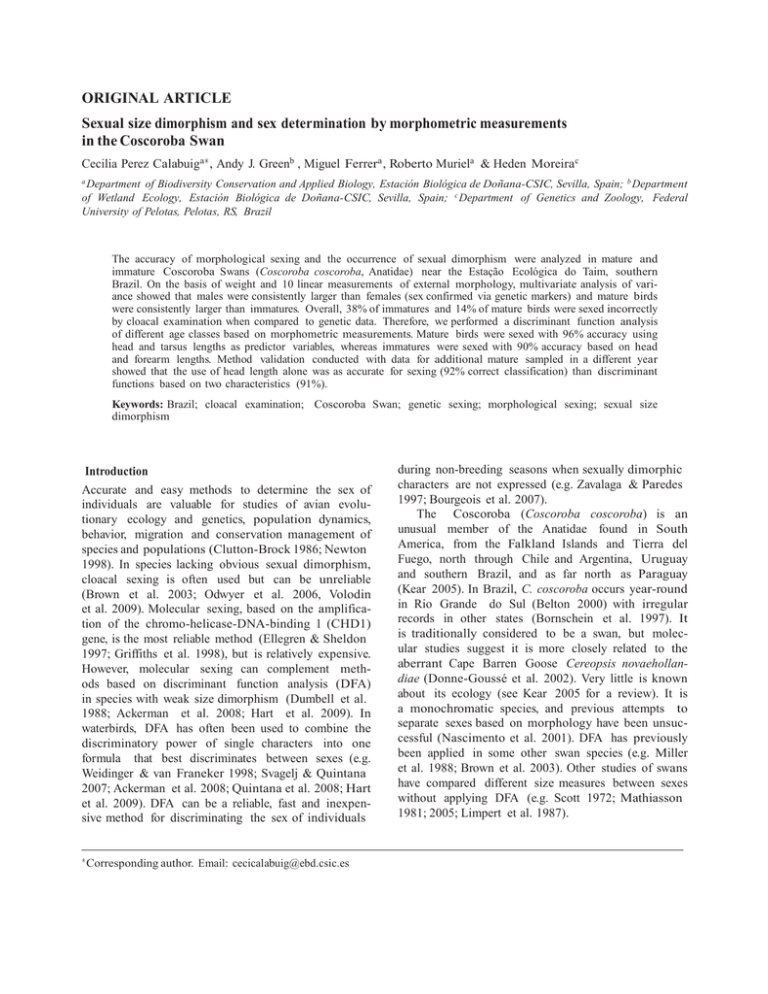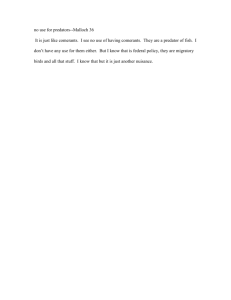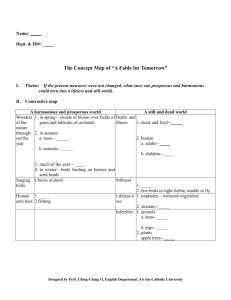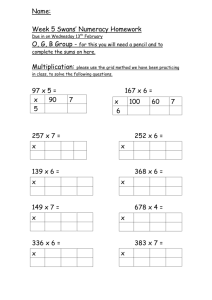
ORIGINAL ARTICLE
Sexual size dimorphism and sex determination by morphometric measurements
in the Coscoroba Swan
Cecilia Perez Calabuiga∗ , Andy J. Greenb , Miguel Ferrera , Roberto Muriela & Heden Moreirac
a Department
of Biodiversity Conservation and Applied Biology, Estación Biológica de Doñana-CSIC, Sevilla, Spain; b Department
of Wetland Ecology, Estación Biológica de Doñana-CSIC, Sevilla, Spain; c Department of Genetics and Zoology, Federal
University of Pelotas, Pelotas, RS, Brazil
The accuracy of morphological sexing and the occurrence of sexual dimorphism were analyzed in mature and
immature Coscoroba Swans (Coscoroba coscoroba, Anatidae) near the Estação Ecológica do Taim, southern
Brazil. On the basis of weight and 10 linear measurements of external morphology, multivariate analysis of variance showed that males were consistently larger than females (sex confirmed via genetic markers) and mature birds
were consistently larger than immatures. Overall, 38% of immatures and 14% of mature birds were sexed incorrectly
by cloacal examination when compared to genetic data. Therefore, we performed a discriminant function analysis
of different age classes based on morphometric measurements. Mature birds were sexed with 96% accuracy using
head and tarsus lengths as predictor variables, whereas immatures were sexed with 90% accuracy based on head
and forearm lengths. Method validation conducted with data for additional mature sampled in a different year
showed that the use of head length alone was as accurate for sexing (92% correct classification) than discriminant
functions based on two characteristics (91%).
Keywords: Brazil; cloacal examination; Coscoroba Swan; genetic sexing; morphological sexing; sexual size
dimorphism
Introduction
Accurate and easy methods to determine the sex of
individuals are valuable for studies of avian evolutionary ecology and genetics, population dynamics,
behavior, migration and conservation management of
species and populations (Clutton-Brock 1986; Newton
1998). In species lacking obvious sexual dimorphism,
cloacal sexing is often used but can be unreliable
(Brown et al. 2003; Odwyer et al. 2006, Volodin
et al. 2009). Molecular sexing, based on the amplification of the chromo-helicase-DNA-binding 1 (CHD1)
gene, is the most reliable method (Ellegren & Sheldon
1997; Griffiths et al. 1998), but is relatively expensive.
However, molecular sexing can complement methods based on discriminant function analysis (DFA)
in species with weak size dimorphism (Dumbell et al.
1988; Ackerman et al. 2008; Hart et al. 2009). In
waterbirds, DFA has often been used to combine the
discriminatory power of single characters into one
formula that best discriminates between sexes (e.g.
Weidinger & van Franeker 1998; Svagelj & Quintana
2007; Ackerman et al. 2008; Quintana et al. 2008; Hart
et al. 2009). DFA can be a reliable, fast and inexpensive method for discriminating the sex of individuals
∗
Corresponding author. Email: cecicalabuig@ebd.csic.es
during non-breeding seasons when sexually dimorphic
characters are not expressed (e.g. Zavalaga & Paredes
1997; Bourgeois et al. 2007).
The Coscoroba (Coscoroba coscoroba) is an
unusual member of the Anatidae found in South
America, from the Falkland Islands and Tierra del
Fuego, north through Chile and Argentina, Uruguay
and southern Brazil, and as far north as Paraguay
(Kear 2005). In Brazil, C. coscoroba occurs year-round
in Rio Grande do Sul (Belton 2000) with irregular
records in other states (Bornschein et al. 1997). It
is traditionally considered to be a swan, but molecular studies suggest it is more closely related to the
aberrant Cape Barren Goose Cereopsis novaehollandiae (Donne-Goussé et al. 2002). Very little is known
about its ecology (see Kear 2005 for a review). It is
a monochromatic species, and previous attempts to
separate sexes based on morphology have been unsuccessful (Nascimento et al. 2001). DFA has previously
been applied in some other swan species (e.g. Miller
et al. 1988; Brown et al. 2003). Other studies of swans
have compared different size measures between sexes
without applying DFA (e.g. Scott 1972; Mathiasson
1981; 2005; Limpert et al. 1987).
.
The present study describes sexual dimorphism
of immature and mature Coscoroba in Brazil, and
compares the accuracy of alternative sexing methods.
The main objectives were to: (a) determine the accuracy of cloacal examination, by comparing the results
with those from molecular sexing; (b) present typical
morphometric measures of Coscoroba, and determine
differences between the sexes and two age classes identifiable by plumage characteristics; (c) develop discriminant models to facilitate the sexing of birds based on
morphometry; and (d) compare the accuracy of DFA
with that of sexing by cloacal examination.
Materials and methods
Study area
Rio Grande do Sul State in the southern tip of Brazil
has a big lagoon complex in the southern portion of its
coastal plain, formed by Patos, Mirim, and Mangueira
Lagoons and other smaller lakes. All birds were captured near the “Estação Ecológica do Taim”, an area
located in the southern coastal plain of RS, between
the counties of Rio Grande and Santa Vitória do
Palmar (∼32◦ 23 W, 52◦ 32 W). This area was chosen because it is within the most important area for
breeding and molting of Coscoroba in Brazil (Seijas
2001).
Capture of birds and sampling
Birds were captured by hand from a boat during
flightless wing molt between August and January
(Nascimento et al. 2001; Seijas 2001) in three consecutive seasons (2005, 2006 and 2007). Birds were divided
into two groups: immatures (fledged but less than two
years old) and matures (>2 years old) according to
plumage characteristics (Johnsgard 1978). Coscoroba
Swans have red eyes, legs, feet and bill from immature to mature age classes but there are differences in
the plumage pattern. The adult’s definitive plumage is
totally white with the exception of a black tip on the
first six external primaries.
Although plumage is mainly white, immature
Coscoroba Swans have brownish down feathers and
brightish brown plumes all over the body and have
grayish brown stains on the tail, back and wings
(in primaries, secondaries and upper wing coverts).
Mature swans have gray down feathers only on the
back and under the wings (axillaries). They usually
display more than six primaries with grayish brown
fleckings but very rarely on the secondaries (Calabuig
et al. 2010).
The immature group consisted of 41 individuals
(19, 11 and 11 for 2005, 2006 and 2007, respectively).
The mature group consisted of 345 individuals (120,
123 and 102 for 2005, 2006 and 2007, respectively).
Morphometric measurements
Birds were weighed with a balance (to the nearest 20 g)
and 10 biometric measures were taken by the same
person (CPC). A digital caliper was used to measure
the following (to the nearest 0.1 mm): head length
(length of head to the occipital-tip of the bill), bill
height, bill depth (maximum width of the bill), nostril (distal edge of a nostril to the end of the bill), total
culmen and tarsus length (on the left side of the body).
A ruler was used to measure the following (to the nearest 1 mm): tail (from the preen gland), wing length
without feathers (metacarpophalangeal articulation),
forearm (Ferrer & De le Court 1992) and neck length.
Before releasing, all swans were banded with a numbered metal CEMAVE-IBAMA ring. Recaptures were
readily identified, and data were only used for each
individual on the first capture.
Cloacal and genetic sex determination
Genital identification
Cloacal examination was carried out by CPC, identifying “males” by the presence of a visible erectile groove
penis on the ventral wall of the cloaca (Proctor &
Lynch 1993; Brown et al. 2003; Mathiasson 2005).
DNA identification
Blood (3 ml) was taken from each bird from the wing
vein and samples were stored in Vacutainer tubes with
EDTA and kept cool in ice, until processing. Blood
samples were analyzed in the Biotechnology Center
(CenBiot), Federal University of Pelotas, Brazil. DNA
extraction was performed according to the procedures
of Lahiri and Nurnberger (1991) and DNA samples
were amplified using primers described by He et al.
(2005) for the Tundra Swan (Cygnus atratus). The
PCR amplifications were carried out in the reaction
mixture of Ito et al. (2003). After amplification, the
PCR products were separated on a 1% agarose gel
(synthesized by Sangon Co., Shangai, China), stained
with ethidium bromide (Sangon Co.) and visualized
under UV light.
Data analyses
We used multivariate analysis of variance (MANOVA)
to compare mean differences between age and sex
groups for morphological measurements and body
mass. Also, one-way analysis of variance was used to
determine whether individual measures varied with sex
in each age group (Sokal & Rohlf 1995). For both
analyses, we used only the 225 mature Coscorobas
sampled during the 2006 and 2007 seasons (those used
for DFA, see below). Differences were considered significant at p ≤ 0.05. All data satisfied Lilliefors and
Levene tests of normality.
For all variables, we calculated a sexual size
dimorphism index as: SSD = {(xm − x̄f )/x̄f } × 100
(Weidinger & van Franeker 1998; Svagelj & Quintana
2007); where x̄m and x̄f are the mean values of different age males and females, respectively. The coefficient
of variation (CV = (SD/x̄) × 100) was calculated for
each sex and averaged between them (Fletcher &
Hamer 2003) to indicate the degree of variability of
each measurement (Sokal & Rohlf 1995).
DFAs were developed separately for immature and
mature birds. We excluded body mass from these analyses since it varies greatly over time (Croxall 1995;
Svagelj & Quintana 2007). The performance of each
single measurement as a discriminating variable (univariate DFA) was evaluated. Forward DFAs were
applied to obtain combinations of characteristics (discriminant functions) that best distinguished the sexes
(see Tabachnick & Fidell 1996; Phillips & Furness
1997).
For immature birds, the DFA was applied to all
individuals. For mature birds, the DFA was applied
to 225 Coscorobas sampled in 2006 and 2007. For
both age classes, the effectiveness of the analyses was
assessed, first in terms of the proportion of birds of
known sex that were classified correctly, and second by
jackknife validation. Correct classification rates tend
to be overestimated when DFAs are validated with the
same sample used to generate them (Tabachnick &
Fidell 1996). The jackknife validation is a process in
which each individual case is classified using a function
obtained from the total sample, excluding the individual case to be classified (Tabachnick & Fidell 1996).
Furthermore, the accuracy of DFAs for mature birds
was confirmed by applying the resulting functions to a
novel dataset, composed of 120 birds captured in the
2005 season.
immature birds; overall, 38% of immature Coscoroba
were sexed incorrectly. Among mature birds, overall,
14% of mature Coscoroba were sexed incorrectly.
Morphometric differences according to sex and age
Analysis of the whole dataset showed that mature
Coscoroba were larger than immatures and males were
bigger than females, with no age × sex interaction
(MANOVA: age: F11, 242 = 4.6, p < 0.01, Wilks = 0.82;
sex: F = 29, p < 0.01, Wilks = 0.43; and age × sex:
F11, 354 = 1.5, p = 0.1, Wilks = 0.93). Thus, in each
age cohort, males were larger than females in all measurements, except in tail length for immature birds
(Tables 1 and 2).
In immature birds, characteristics that showed the
highest sexual size dimorphism were mass and tail,
whereas bill height, wing and tail were less dimorphic.
Mass showed the highest within-sex variation whilst
head length had the lowest (Table 1). In mature birds,
mass, tarsus and neck length showed the highest sexual
size dimorphisms whereas bill depth and tail were less
dimorphic. Mass and neck length showed the highest
within-sex variation whilst bill depth and head length
had the lowest (Table 2).
Table 1. Body measurements (mean ± SD and range,
in mm), coefficients of variation (CV) and sexual size
dimorphism index (SSD) for immature male and female
Coscoroba Swans (Coscoroba coscoroba) from southern Rio
Grande do Sul, Brazil. All measured characteristics differed
between the sexes (p < 0.05) except tail length. CV was first
calculated for each sex and then averaged.
Body
measurement
Mass (g)
Total culmen
Nostril
Bill height
Bill depth
Head length
Results
Cloacal and genetic sex determination
Genetic sexing showed that there were 14 males and
27 females among young birds, and 189 males and 156
females among mature birds. Some birds were incorrectly classified by cloacal examination. Although
genetic females were rarely misclassified as “males”,
males were often wrongly identified as “female”.
Cloacal inspection was particularly unreliable for
Tarsus
Wing
Forearm
Tail
Neck length
Male
Female
One-way
ANOVA
n = 14
n = 27
F1.39
CV
SSD
3760 ± 460
2650 – 4400
70.6 ± 4.6
62.5 – 79.2
52.7 ± 2.8
48.6 – 56.6
25.7 ± 1.0
23.6 – 27
30.2 ± 1.4
27.2 – 32.7
138 ± 4.9
129 – 146.3
101.6 ± 5.6
87.8 – 108.2
173.8 ± 7.1
162 – 185
213.1 ± 8.3
200 – 225
183.1 ± 14.7
161 – 205
345.4 ± 24.7
305 – 390
3230 ± 400
2250 – 4100
65.4 ± 2.4
62 – 73
48.7 ± 2.6
41.3 – 56.3
24.5 ± 1.5
22.2 – 28.8
28.5 ± 1.3
24 – 30.1
129.6 ± 3.1
123.1 – 135
95.4 ± 4.4
85 – 104
164.1 ± 9.7
145 – 185
195.9 ± 8.8
175 – 215
173.2 ± 21.9
107 – 220
315 ± 21.8
260 – 370
14.4
14.4
16.1
22.7
6.1
8.0
21.4
6.6
8.2
6
4.9
13.7
5.2
6.0
46.6
4.2
6.5
14.6
5.7
6.5
10.9
6
5.9
37.7
5.9
8.8
2.5
11.4
5.7
16.1
8.3
9.6
6.7
(%)
.
Table 2. Body measurements (mean ± SD and range, in
mm), coefficients of variation (CV) and sexual size dimorphism index (SSD) for mature male and female Coscoroba
Swans (Coscoroba coscoroba) sampled in 2006 and 2007 in
southern Rio Grande do Sul, Brazil. All measured characteristics differed between the sexes (p < 0.05). CV was first
calculated for each sex and then averaged.
Body
measurement
Males
Females
One-way
ANOVA
n = 125
n = 100
F 1.223
CV
SSD
4000 ± 335
3050 – 5140
70.6 ± 2.6
62.8 – 78.8
52.8 ± 1.6
48.4 – 58.8
26.3 ± 1.1
23.7 – 29
30.7 ± 0.8
29 – 33.3
140.1 ± 2.8
132.2 – 147
105.8 ± 3.8
93.3 – 117.2
178.7 ± 7.5
152 – 200
212.6 ± 8
177.0 – 230
175.4 ± 6.9
145 – 190
355.9 ± 18.6
275 – 400
3340 ± 360
2400 – 4500
65.5 ± 2.3
59.8 – 71.8
49 ± 2.2
40 – 59.2
24.6 ± 1.1
22.2 – 27.5
29.2 ± 0.9
26.4 – 31.3
131.2 ± 2.8
123.8 – 138.8
96.1 ± 3.4
84.6 – 104.5
165 ± 8.6
130 – 186
196.4 ± 7.7
168 – 217
166.4 ± 8.5
141 – 187
317.3 ± 20.2
265 – 365
197.2
12.9
19.8
241.5
5.1
7.8
221.7
5.3
7.8
136.3
5.5
7.1
152.2
3.7
4.9
548.9
3.9
6.8
397.3
6
162.8
6.1
8.3
235.3
5.5
8.2
76.2
5.1
5.4
2006–2007
Mass (g)
Total culmen
Nostril
Bill height
Bill depth
Head length
Tarsus
Wing
Forearm
Tail
Neck length
Table 3. Accuracy of sexing of immature Coscoroba Swans
using single measurements or combinations in a discriminant function (DF1 = head length and forearm). Identical
results were obtained by the jackknife method (see text).
Original sample (n = 41) (% correct
classification)
(%)
Variables
221.1
8
10.1
12.2
Discriminant analysis
Immature swans
Head length was the most accurate single indicator
of sex, correctly classifying 88% of birds (Table 3).
Coscorobas with head lengths longer than 135 mm
were classified as males. Jackknife validation provided
exactly the same classifications as those produced by
DFAs for all single measurements. DFA retained head
length and forearm as the best predictor variables and
excluded others. This model correctly classified 79%
of females and 96% of males (Table 3). Only three
females and one male were misclassified. The discriminant function obtained for immature Coscorobas was:
DF1 = 0.43 (head length) + 0.13 (forearm) – 84.6.
Values of DF1 > 0 identified males and values of
DF1 < 0 identified females.
Total culmen
Nostril
Bill height
Bill depth
Head length
Tarsus
Wing
Forearm
Tail
Neck length
DF1
Wilks’
lambda
Males
Females
Overall
0.63
0.65
0.85
0.74
0.45
0.73
0.78
0.51
0.94
0.74
0.42
64.3
71.4
64.3
78.6
86
78.6
78.6
78.6
64.3
78.6
78.6
92.6
89
74.1
70.4
89
66.7
70.4
81.5
66.7
70.4
96.3
83
83
70.7
73.2
88
70.7
73.2
80.5
66
73.2
90.2
Cut-off
point
(mm)
69.3
51.9
26.2
30.1
135.0
101.0
173.8
207.1
202.4
339.0
only two Coscorobas differed between classifications
(changing the correct classification to 86% for males
and 85% overall). Validation with a novel sample of
birds provided slightly different classifications when
compared with DFA, decreasing the accuracy for
all measures except for bill height and bill depth
(Table 4). DFA retained head length and tarsus as the
best predictors. This model correctly classified 96% of
females and 95% of males (overall success, 96%, three
females and four males misclassified) with a low value
for Wilks’ lambda (Table 4). The DF1 obtained for
mature Coscorobas was: DF1 = 0.84 (head length)
+ 0.38 (tarsus) – 152.6. This model was represented
in Figure 1 where mature Coscorobas were classified
according to head length and tarsus measurements.
Misclassifications were unusually large females misclassified as males.
A DFA with only head length as predictor variable classified 93% of cases correctly, with a value
of Wilks’ lambda close to the best model with head
length and tarsus together. This alternative discriminant function (DF2) was: DF2 = 1.1 (head length)
– 150. DF2 performed slightly better than DF1 when
validated against a new sample of birds (Table 4), with
92% of individuals sexed correctly.
Discussion
Mature swans
Head length was the most accurate single indicator of sex, correctly classifying 93% of Coscorobas
(Table 4). Jackknife validation provided exactly the
same classifications as those produced by DFAs for all
single measurements except for nostril length, where
Sex determination by cloacal inspection
Although cloacal examination is a widely used method
for sexing waterfowl (e.g. Green 2000; Gray & Hamer
2001; Nascimento et al. 2001), it has several disadvantages. This method requires observers with considerable experience, is only possible during the breeding
Table 4. Accuracy of sexing of adult Coscoroba Swans using single measurements and a discriminant function (DF1 = head
length and tarsus) for 2006 and 2007 (original sample included in discriminant analyses) and 2005 (used for validation, see text).
A jackknife method produced identical results to those shown here for the original sample, with the exception of nostril (see
text).
Original sample (n = 225) (% correct classification)
Variables
Total culmen
Nostril
Bill height
Bill depth
Head length
Tarsus
Wing
Forearm
Tail
Neck length
DF1
Wilks’ lambda
0.48
0.5
0.62
0.59
0.29
0.36
0.58
0.49
0.74
0.5
0.26
New sample cross-validation (n = 120)
Males
Females
Overall
Males
Females
Cut-off point (mm)
88.8
88
75
80
94.4
90.4
83.2
87.9
76.6
87.2
95.2
87.9
83.8
81
77
92
89.9
78
84.8
69.8
82
95.9
88.4
86.2
77.7
78.7
93.3
90.1
80.9
86.5
73.6
84.9
95.5
92.2
98.4
67.2
100
91
86
87.5
97
98.4
73.5
91
75
54
90.2
78.4
93
87.5
60.3
66.1
48
80.4
91.1
67.8
48.8
25.3
19.4
136.3
100.4
173.3
203.4
169.2
330.8
Figure 1. Plot of 329 mature Coscoroba Swans from southern Rio Grande do Sul, Brazil, according to head length and forearm
length. Males and females were identified by genetic sexing. The straight line represents 50% probability of sex classification
according to the discriminant function.
.
period for some species, and can cause internal damage to the bird due to the pressure applied during penis
visualization (e.g. Sax & Hoi 1998; Lombardo 2001;
Oliveira et al. 2004). We found it to be an unreliable
method for the Coscoroba, owing to the difficulties of
observing the penis, especially in young birds where
penis development is incomplete (Odwyer et al. 2006).
Similar levels of inaccuracy have been recorded in
petrels (Odwyer et al. 2006) and in whistling ducks
(genus Dendrocygna, Volodin et al. 2009). We do not
believe that the error in sexing can be attributed to
an observer effect in our study because the person
who sexed the swans was an experienced specialist
who has been ringing waterbirds for 20 years. Previous
studies relying exclusively on cloacal inspection to sex
Anatidae (e.g. Green 2000) may also contain errors.
Coscoroba Swans reach maturity when they are
two years old and start breeding at three to four
years old (Wilmore 1979; Silva-García & Brewer
2007). Although birds are generally assumed to have
determinate growth, our results showed that mature
Coscoroba differed significantly in size from swans less
than two years of age, implying that growth continues
in this species for an extended period prior to reaching sexual maturity (Kirkwood et al. 1989; Carrier &
Auriemma 1992; Tumarkin-Deratzian et al. 2006).
ANOVAs of individual measures showed that mass,
bill depth, head length, tarsus, tail and neck length
were all significant greater in mature birds (results
not shown). Growth rates of large, precocious birds
such as swans are particularly slow (Ricklefs 1973;
Carrier & Auriemma 1992).
Sexual size dimorphism and age effects
Few previous data were available on the morphometrics of Coscoroba (Kear 2005). Our results indicate
significant size dimorphism, with male Coscoroba
generally being larger than females, both for immature
and mature birds. In general, large size may be advantageous in male swans and geese because they are
responsible for nest protection (Scott 1972; Veselovsky
1973; Hawkins 1986; Whitehead & Tschirner 1990)
or may need to defend females against males seeking extra-pair copulations (Mineau & Cooke 1979;
McKinney et al. 1983; Welsh & Sedinger 1990;
Gauthier & Tardif 1991; Choinière & Gauthier 1995).
As in the Cape Barren Goose, both Coscoroba sexes
care for their cygnets and maintain long-term pair
bonds, but the male is primarily a guardian and helps
with nest building but not incubation.
Mass and neck length showed the highest degree of
sexual size dimorphism in Coscoroba, but head length
was the most useful single variable to distinguish
between males and females, because it had an intermediate level of dimorphism combined with particularly
low CV. In most bird species, intraspecific variation is
markedly lower in the bill and other body parts associated with food intake than in the rest of the body,
perhaps as a result of adaptation to particular foraging behavior and diet (Miller et al. 1988). However,
different CVs between measures can also reflect differences in measurement error (Yezerinac et al. 1992),
and neck length is likely to have had a relatively high
measurement error in our study. Our findings were
consistent with previous studies that showed that head
(e.g. Veselovsky 1973; Miller et al. 1988; Brown et al.
2003), tarsus (e.g. Veselovsky 1973; Brown et al. 2003;
Mathiasson 2005) and forearm (e.g. Mathiasson 2005)
lengths are key characteristics to differentiate sexes in
Anseriformes.
Sex determination by discriminant function analysis
Discriminant functions were developed using only two
morphometric variables: head and forearm lengths
for immature birds, and head and tarsus lengths for
mature birds, resulting in 90% and 96% of correct
sexual classification, respectively. These classification
rates are much higher than those based on cloacal
inspection. However, cross-validation with a new sample of mature swans suggested that a single measure
(head length) was the most reliable sexing method,
with 92% correct classification. While jackknife validation reveals influential observations that can bias
DFA, cross-validation is a more rigorous validation
process and should ideally involve a new sample of
individuals measured at different times, locations and
by different observers (Tabachnick & Fidell 1996). We
suspect that discriminant functions would provide a
better alternative to cloacal sexing in many other bird
species.
More research is required to calibrate the use of
our discriminant functions in other Coscoroba populations with other observers. Given the results of the
validation with novel data, sex determination based
on head length is likely to be the most robust discriminant function method. When cloacal inspection
is carried out without genetic sexing, these data can
be plotted together with head length data to establish
the best cut-off point for sex determination based on
morphometrics. For example, in a population in which
Coscoroba were physically smaller, the cut-off points
of Tables 3 and 4 for head length might be too high.
Acknowledgments
We would like to thank S. Scherer for his valuable
assistance in the field. We thank Dr. B. Vaz, R. Tavares,
J. Camacho and L. Bassini from the Department of
Genetics and Zoology, Federal University of Pelotas,
RS, Brazil for technical help in carrying out DNA
extraction.
References
Ackerman JT, Takekawa JY, Bluso JD, Yee JL, Eagles-Smith CA.
2008. Gender identification of Caspian Terns using external morphology and discriminant function analysis. Wilson J Ornithol.
120(2):378–383.
Belton W. 2000. Aves do Rio Grande do Sul: Distribuição e biologia.
2nd ed. São Leopoldo (Brazil): Editora UNISINOS.
Bornschein MR, Reinart BL, Pichorin M. 1997. Notas sobre algumas aves novas ou pouco conhecidas no sul do Brasil. Ararajuba.
5(1):53–59.
Bourgeois K, Curé C, Legrand J, Gómez-Díaz E, Vidal E, Aubin
T, Mathevon N. 2007. Morphological versus acoustic analysis:
what is the most efficient method for sexing yelkouan shearwaters
Puffinus yelkouan? J Ornithol. 148:261–269.
Brown AW, Brown LM, Stevick PT. 2003. Sexing Mute Swans
Cygnus olor by discriminant analysis. Ring & Migr. 21:
174–180.
Calabuig CP, Ferrer M, Muriel R, Tilgar V. 2010. Plasma alkaline
phosphatase as a sensitive indicator of age and skeletal development in wild Coscoroba Swans. Wildlife Res. 37(6):504–511.
Carrier DR, Auriemma J. 1992. A developmental constraint on the
fledging time of birds. Biol J Linn Soc. 47(1):61–77.
Choinière L, Gauthier G. 1995. Energetics of reproduction in female
and male Greater Snow Geese. Oecologia. 103(3):379–389.
Clutton-Brock TH. 1986. Sex ratio variation in birds. Ibis.
128(3):317–329.
Croxall JP. 1995. Sexual size dimorphism in seabirds. Oikos.
73(3):399–403.
Donne-Goussé C, Laudet V, Hanni C. 2002. A molecular phylogeny of Anseriformes based on mitochondrial DNA analysis.
Mol Phylogenet Evol. 23(3):339–356.
Dumbell GS, McArdle BH, Craig JL. 1988. Discriminating the sex
of birds: a study of brown teal (Anas aucklandica chlorotis). New
Zeal J Zool. 15(1):47–53.
Ellegren H, Sheldon BC. 1997. New tools for sex identification and
the study of sex allocation in birds. Tree. 12(7):255–259.
Ferrer M, De Le Court C. 1992. Sex determination in the Spanish
Imperial Eagle. J Field Ornithol. 63(3):359–364.
Fletcher KL, Hamer KC. 2003. Sexing terns using biometrics:
the advantage of within-pair comparisons. Bird Study. 50(1):
78–83.
Gauthier G, Tardif J. 1991. Female feeding and male vigilance
during nesting in greater snow geese. Condor. 93(3):701–711.
Gray CM, Hamer KC. 2001. Food provisioning behaviour of male
and female Manx Shearwaters Puffinus puffinus. Anim Behav.
62(1):117–121.
Green AJ. 2000. The scaling and selection of sexually dimorphic
characters: an example using the Marbled Teal. J Avian Biol.
31(3):345–350.
Griffiths R, Double MC, Orr K, Dawson RJG. 1998. A DNA test
to sex most birds. Mol Ecol. 7(8):1071–1075.
Hart T, Fitzcharles E, Trathan PN, Coulson T, Rogers AD. 2009.
Testing and improving the accuracy of discriminant function
tests: a comparison between morphometric and molecular sexing
in Macaroni Penguins. Waterbirds 32(3):437–443.
Hawkins LL. 1986. Nesting behaviour of male and female whistling
swans and implications of male incubation. Wildfowl. 37:5–27.
He P-J, Yu J-Q, Fang S-G. 2005. Sex identification of Black Swan
(Cygnus atratus) using the Locus/specific and Implications for
this Reproduction. Reprod Domest Anim. 40(3):196–198.
Ito H, Sudo-Yamaji A, Abe M, Murase T, Tsubota T. 2003. Sex
identification by alternative polymerase chain reaction methods
in Falconiformes. Zool Sci. 20(3):339–344.
Johnsgard P. 1978. Ducks, Geese and Swans of the World. 1st ed.
Lincoln (NE): University of Nebraska Press.
Kear J. editor. 2005. Ducks, Geese and Swans. Vol 1. Oxford (UK):
Oxford University Press.
Kirkwood JK, Duignan PJ, Kember NF, Bennett PM, Price DJ.
1989. The growth rate of the tarsometatarsus bone in birds. J
Zool. 217(3):403–416.
Lahiri DK, Nurnberger JI Jr. 1991. A rapid non enzymatic method
for the preparation of HMW DNA from blood for RFLP studies.
Nucleic Acids Res. 19(19):5444.
Limpert RJ, Allen HA, Sladen WJL. 1987. Weights and measurements of wintering Tundra Swans. Wildfowl. 38:108–113.
Lombardo MP. 2001. Individual and seasonal variation in external
genitalia of male Tree Swallows. Auk. 118(3):789–795.
Mathiasson S. 1981. Weight and growth rates of morphological
characters of Cygnus olor. Paper presented at: II ISS 1981.
Proceedings of the 2nd International Swan Symposium; 1981 Feb
21–23; Sapporo, Japan.
Mathiasson S. 2005. Biometrics and structures of the Mute Swan,
Cygnus olor – parameters and technique used in a Swedish
project. Göteborgs Naturhistoriska Museum Årstryck. 77–86.
McKinney F, Derrickson SR, Mineau P. 1983. Forced copulation in
waterfowl. Behaviour. 86(3):250–294.
Miller SL, Gregg MA, Kuritsubo AR, Combs SM, Murdock MK,
Nilsson JA, Noon BR, Botzler RG. 1988. Morphometric variation in Tundra Swans: relationships among sex and age classes.
Condor. 90:802–815.
Mineau P, Cooke F. 1979. Territoriality in Snow Geese or the protection of parenthood-Ryder’s and Inglis’s hypothesis re-assessed.
Wildfowl. 30:16–19.
Nascimento JLX, Flores JM, Ataguile BS, Koch M, Barbosa S,
Parreira Dos Santos PJ. 2001. Biological aspects of the Blacknecked Swan (Cygnus melancoryphus) and Coscoroba Swan
(Coscoroba coscoroba) in Rio Grande do Sul state, Brazil.
Melopsittacus. 4(1):31–38.
Newton I. 1998. Population limitation in birds. San Diego (CA):
Academic Press.
Odwyer TW, Priddel D, Carlile N, Bartle JA, Buttemer WA. 2006.
An evaluation of three field techniques for sexing Gould’s Petrels
(Pterodroma leucoptera) (Procellariidae). Emu. 106(3):245–252.
Oliveira CA, Silva RM, Santos MM, Mahecha AB. 2004. Location
of the ureteral openings in the cloacas of tinamous, some
ratite birds, and crocodilians: A primitive character. J Morphol.
260(2):234–246.
Phillips RA, Furness RW. 1997. Predicting the sex of parasitic Jaegers by discriminant analysis. Colon Waterbird. 20(1):
14–23.
Proctor NS, Lynch PJ. 1993. Manual of Ornithology: Avian
Structure and Function. New Haven (CT): Yale University Press.
Quintana F, López G, Somoza G. 2008. A cheap and quick method
for DNA-based sexing of birds. Waterbirds. 31(3):485–488.
Ricklefs RE. 1973. Patterns of growth in birds. II. Growth rate and
mode of development. Ibis. 115(2):177–201.
Sax A, Hoi H. 1998. Individual and temporal variation in cloacal
protuberance size of male Bearded Tits (Panurus biarmicus). Auk.
115(4):964–969.
Scott P. 1972. The swans. Boston (MA): Houghton Mifflin
Company.
Seijas SM. 2001. Censo Neotropical de Cisnes, período 1998–2000.
Buenos Aires (Argentina): L.O.L.A.
Silva-García CM, Brewer GL. 2007. Breeding behavior of the
Coscoroba Swan (Coscoroba coscoroba) in El Yali wetland, central Chile. Ornitol. Neotrop. 18:573–585.
.
Sokal RR, Rohlf FJ. 1995. Biometry. 3rd ed. New York (NY): W. H.
Freeman and Company.
Svagelj SW, Quintana F. 2007. Sexual size dimorphism and determination by morphometric measurements in breeding Imperial
Shags (Phalacrocorax atriceps). Waterbirds. 30(1):97–102.
Tabachnick BG, Fidell LS. 1996. Using multivariate statistics. 3rd
ed. New York (NY): Harper Collins Publishers.
Tumarkin-Deratzian AR, Vann DR, Dodson P. 2006. Bone surface
texture as an ontogenetic indicator in long bones of the Canada
goose Branta canadensis (Anseriformes: Anatidae). Zool J Linn
Soc. 148(2):133–168.
Veselovsky Z. 1973.The breeding biology of Cape Barren
geese Cereopsis novaehollandiae. International Zoo Yb. 13(1):
48–55.
Volodin I, Kaiser M, Matrosova V, Volodina E, Klenova A, Filatova
O, Kholodova M. 2009. The technique of noninvasive distant sexing for four monomorphic Dendrocygna whistling duck species by
their loud whistles. Bioacoustics. 18(3):277–290.
Weidinger K, van Franeker JA. 1998. Applicability of external
measurements to sexing of the Cape Petrel Daption capense at
within-pair, within-population and between-population scales. J
Zool. 245:473–482.
Welsh D, Sedinger JS. 1990. Extra-pair copulations in black brant.
Condor. 92(1):242–244.
Whitehead PJ, Tschirner K. 1990. Eggs and hatchlings of
the Magpie Goose Anseranas semipalmata. Emu. 90(3):
154–160.
Wilmore SB. 1979. Swans of the World. Taplinger Publishing
Company, New York, USA.
Yezerinac SM, Lougheed SC, Handford P. 1992. Measurement
error and morphometric studies: statistical power and observer
experience. Syst Biol. 41(4):471–482.
Zavalaga CB, Paredes R. 1997. Sex determination of adult
Humboldt penguins using morphometric characters. J Field
Ornithol. 68(1):102–112.





